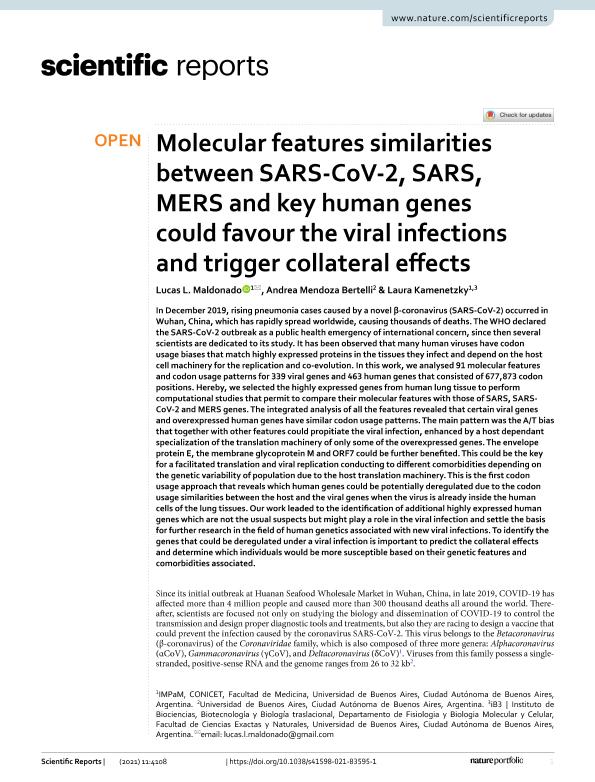Artículo
Molecular features similarities between SARS-CoV-2, SARS, MERS and key human genes could favour the viral infections and trigger collateral effects
Fecha de publicación:
18/02/2020
Editorial:
Nature Research
Revista:
Scientific Reports
ISSN:
2045-2322
Idioma:
Inglés
Tipo de recurso:
Artículo publicado
Clasificación temática:
Resumen
In December 2019, rising pneumonia cases caused by a novel β-coronavirus (SARS-CoV-2) occurred in Wuhan, China, which has rapidly spread worldwide, causing thousands of deaths. The WHO declared the SARS-CoV-2 outbreak as a public health emergency of international concern, since then several scientists are dedicated to its study. It has been observed that many human viruses have codon usage biases that match highly expressed proteins in the tissues they infect and depend on the host cell machinery for the replication and co-evolution. In this work, we analysed 91 molecular features and codon usage patterns for 339 viral genes and 463 human genes that consisted of 677,873 codon positions. Hereby, we selected the highly expressed genes from human lung tissue to perform computational studies that permit to compare their molecular features with those of SARS, SARS-CoV-2 and MERS genes. The integrated analysis of all the features revealed that certain viral genes and overexpressed human genes have similar codon usage patterns. The main pattern was the A/T bias that together with other features could propitiate the viral infection, enhanced by a host dependant specialization of the translation machinery of only some of the overexpressed genes. The envelope protein E, the membrane glycoprotein M and ORF7 could be further benefited. This could be the key for a facilitated translation and viral replication conducting to different comorbidities depending on the genetic variability of population due to the host translation machinery. This is the first codon usage approach that reveals which human genes could be potentially deregulated due to the codon usage similarities between the host and the viral genes when the virus is already inside the human cells of the lung tissues. Our work leaded to the identification of additional highly expressed human genes which are not the usual suspects but might play a role in the viral infection and settle the basis for further research in the field of human genetics associated with new viral infections. To identify the genes that could be deregulated under a viral infection is important to predict the collateral effects and determine which individuals would be more susceptible based on their genetic features and comorbidities associated.
Palabras clave:
SARS-CoV-2, SARS, MERS
,
CODON USAGE
,
VIRAL GENES
,
COVID-19
Archivos asociados
Licencia
Identificadores
Colecciones
Articulos(IMPAM)
Articulos de INSTITUTO DE INVESTIGACIONES EN MICROBIOLOGIA Y PARASITOLOGIA MEDICA
Articulos de INSTITUTO DE INVESTIGACIONES EN MICROBIOLOGIA Y PARASITOLOGIA MEDICA
Citación
Maldonado, Lucas Luciano; Mendoza Bertelli, Andrea Cristina; Kamenetzky, Laura; Molecular features similarities between SARS-CoV-2, SARS, MERS and key human genes could favour the viral infections and trigger collateral effects; Nature Research; Scientific Reports; 11; 4108; 18-2-2020; 1-17
Compartir
Altmétricas




